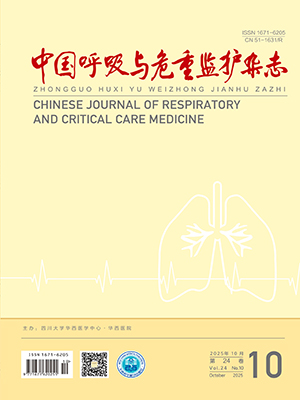Objective To investigate whether pulse pressure variation( ΔPP) reflect the effects of PEEP and fluid resuscitation ( FR) on hemodynamic effects. Methods Twenty critical patients with acute lung injury was ventilated with volume control ( VT =8 mL/kg, Ti/Te = 1∶2) , and PaCO2 was kept at 35 to 45 mm Hg. PEEP was setted as 5 cm H2O and 15 cmH2O in randomized order. Hemodynamic parameters including cardiac index, pulse pressure, central venous pressure, etc. were monitered by PiCCO system.Measurements were performed after the application of 5 cmH2O PEEP ( PEEP5 group) and 15 cm H2OPEEP ( PEEP15 group) respectively. When the PEEP-induced decrease in cardiac index ( CI) was gt; 10% ,measurements were also performed after fluid resuscitation. Results Compared with PEEP5 group, CI was decreased significantly in PEEP15 group( P lt;0. 05) , and ΔPP was increased significantly( P lt; 0. 05) . In 14 patients whose PEEP-induced decrease in CI was gt; 10% , fluid resuscitation increased CI from ( 3. 01 ±0. 57) L·min - 1·m- 2 to ( 3. 62 ±0. 68) L·min- 1 ·m- 2 ( P lt;0. 01) , and decreased ΔPP from ( 17 ±3) % to ( 10 ±2) % ( P lt;0. 01) . PEEP15 -induced decrease in CI was correlated negatively with ΔPP on PEEP5 ( r= - 0.91, P lt;0. 01) and with the PEEP15 -induced increase in ΔPP ( r = - 0. 79, P lt;0. 01) . FR-induced changes in CI correlated with ΔPP before FR ( r =0. 96, P lt; 0. 01) and with the FR-induced decrease in ΔPP ( r= - 0. 95, P lt; 0. 01) . Conclusions In ventilated patients with ALI, ΔPP may be a simple anduseful parameter in predicting and assessing the hemodynamic effects of PEEP and FR.
Citation: GU Qin,LIU Ning,YU Jianfeng.. The Clinical Value of Pulse Pressure Variation to Monitor the Fluid Responsiveness and Effects of PEEP in Ventilated Patients with Acute Lung Injury. Chinese Journal of Respiratory and Critical Care Medicine, 2009, 09(4): 388-391. doi: Copy
Copyright © the editorial department of Chinese Journal of Respiratory and Critical Care Medicine of West China Medical Publisher. All rights reserved




